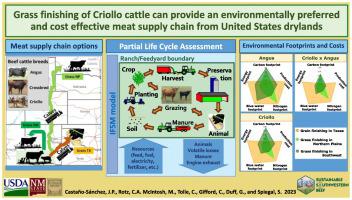Agricultural Systems ( IF 6.1 ) Pub Date : 2023-06-09 , DOI: 10.1016/j.agsy.2023.103694 José P. Castaño-Sánchez , C. Alan Rotz , Matthew M. McIntosh , Cindy Tolle , Craig A. Gifford , Glenn C. Duff , Sheri A. Spiegal

|
CONTEXT
The southwestern United States is experiencing an increasingly warmer and drier climate that is affecting cattle production systems of the region. Adaptation strategies are needed that will not compromise environmental quality or profitability. Options include the use of desert-adapted beef cattle biotypes, such as Rarámuri Criollo cattle, and crossbreds of Criollo with more traditional British breeds. Currently, most calves raised in the Southwest are grain finished, often with irrigated crops produced in the hydrologically-threatened Ogallala Aquifer region. A viable alternative may be grass finishing with the rainfed forage of the arid and semi-arid rangeland of the Southwest or in the temperate grasslands of the Northern Plains.
OBJECTIVE
Compare the environmental impacts and production costs of grain-finishing in Texas and grass-finishing in the Northern plains and the Southwest with traditional Angus cattle vs. Criollo and Criollo x Angus cattle.
METHODS
Nine supply chain strategies were simulated using the Integrated Farm System Model to compare farm-gate life cycle intensities of greenhouse gas emissions (carbon footprint), fossil energy footprint, nitrogen footprint, blue water footprint and production costs using representative (appropriate soils, climate, and management) ranch and feedlot operations.
RESULTS AND CONCLUSIONS
For both finishing options (grass, grain), Criollo x Angus cattle had the best environmental (3%–27% lower), and production cost (4–23% lower) outcomes followed by pure Criollo and then Angus cattle. Crossbred production combined the lower feed supplementation requirements of Criollo cows with heavier final carcasses of offspring from Angus genetics. Crossbred cattle with grass finishing in the Southwest or Northern Plains outperformed on most environmental variables as well as production costs, mostly due to reduced external input requirements (primarily feed). A downside for grass-finished crossbreds was greater carbon footprint (27–42% higher) compared to grain finishing due to greater methane emissions from high forage diets and an extended time to finish. On grasslands where soil C sequestration can be supported, that land-based sequestration may offset the greater greenhouse gas emission from enteric methane of grass-finished beef. Grass finishing in the Northern Plains may provide a more reliable meat supply chain than grass finishing in the Southwest due to the lower risk and less severe consequences of drought.
SIGNIFICANCE
Alternative beef supply chain options using Rarámuri Criollo cattle were found to be sustainable production systems that can be adopted by ranchers in the southwestern United States to adapt to the changing climate.
中文翻译:

Criollo 牛的草加工可以提供来自美国旱地的环保且具有成本效益的肉类供应链
语境
美国西南部正在经历越来越温暖和干燥的气候,这正在影响该地区的牛生产系统。需要不会损害环境质量或盈利能力的适应策略。选项包括使用适应沙漠的肉牛生物型,例如 Rarámuri Criollo 牛,以及 Criollo 与更传统的英国品种的杂交品种。目前,在西南部饲养的大多数小牛都是谷物成品,通常是在受水文威胁的奥加拉拉含水层地区生产的灌溉作物。一个可行的替代方案可能是在西南部的干旱和半干旱牧场或北部平原的温带草原上使用雨养草料进行草坪整理。
客观的
将德克萨斯州谷物加工和北部平原和西南部的草加工与传统安格斯牛与 Criollo 牛和 Criollo x 安格斯牛的环境影响和生产成本进行比较。
方法
使用综合农场系统模型模拟了九种供应链策略,以比较温室气体排放(碳足迹)、化石能源足迹、氮足迹、蓝水足迹和生产成本的农场大门生命周期强度和管理)牧场和饲养场运营。
结果和结论
对于两种加工选择(草、谷物),Criollo x Angus 牛的环境(降低 3%–27%)和生产成本(降低 4–23%)结果最好,其次是纯 Criollo 牛,然后是安格斯牛。杂交生产结合了 Criollo 奶牛较低的饲料补充要求和安格斯遗传学后代较重的最终尸体。在西南或北部平原进行草肥育的杂交牛在大多数环境变量和生产成本方面都表现出色,这主要是由于外部投入需求减少(主要是饲料)。与谷物精加工相比,草精杂交品种的一个缺点是碳足迹更大(高 27-42%),这是因为高牧草日粮产生的甲烷排放量更大,而且完成时间更长。在可以支持土壤固碳的草原上,这种基于陆地的封存可以抵消草制品牛肉的肠道甲烷排放的更多温室气体。由于风险较低且干旱后果较轻,北部平原的草料加工可能比西南地区的草料加工提供更可靠的肉类供应链。
意义
使用 Rarámuri Criollo 牛的替代牛肉供应链选项被发现是可持续的生产系统,美国西南部的牧场主可以采用这些系统来适应不断变化的气候。











































 京公网安备 11010802027423号
京公网安备 11010802027423号